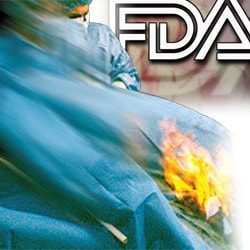
In the face of hundreds of surgery fires yearly, the U.S. Food & Drug Administration (FDA) has scheduled a webinar to help minimize the persistent, “well-understood,” and preventable problem. The FDA says the dangerous issue of surgery fires can be prevented should a surgical team collaborate on prevention, said NapleNews. The fires can lead to […]
 In the face of hundreds of surgery fires yearly, the U.S. Food & Drug Administration (FDA) has scheduled a webinar to help minimize the persistent, “well-understood,” and preventable problem.
In the face of hundreds of surgery fires yearly, the U.S. Food & Drug Administration (FDA) has scheduled a webinar to help minimize the persistent, “well-understood,” and preventable problem.
The FDA says the dangerous issue of surgery fires can be prevented should a surgical team collaborate on prevention, said NapleNews. The fires can lead to significant issues including serious burns, horrendous facial disfigurement, death, trauma to the patient and operating room staff, and OR room and equipment damage and loss.
According to the FDA Safety Initiative, a program focused on educating healthcare professionals, about 550-650 surgical fires occur annually, said NaplesNews. In one case, a man—anesthetized and in an operating room, testified that he heard a nurse screaming “Oh, my God! He’s on fire!” The man said, “And the next thing I remember is … smelling my skin burning.” The man, 68 years old at the time of the accident, suffered second-degree burns to his shoulder, chest and neck; his hair was singed. He was undergoing surgery on March 19, 2008, to have a pacemaker inserted and was in surgery at NCH Downtown Naples Hospital, in Florida, said NaplesNews.
The man’s attorney alleges negligence while the hospital claims it was not negligent and blames the surgeon, who was not a hospital employee. None of the nurses take any responsibility and the hospital’s experts say they believe oxygen under the surgical drape caused it to ignite. Everyone agrees that an alcohol-based antiseptic, DuraPrep, had not dried before the nursing team advised the doctor that he could operate, said NaplesNews. This caused and electrical cauterizing device to ignite. One nurse said the burns happened where alcohol was applied and settled around the patient’s neck.
Judge Hugh Hayes ruled there was sufficient evidence to prove the hospital was liable, regardless of the cause, saying “The patient is in the defendant’s custody and control. The patient is sedated — in essence, out of this world,” he added, wrote Naples News. In this case, all is completed except for financial compensation determination.
According to Mark Bruley, vice president of Accident and Forensic Investigations in Pennsylvania, and a world expert in surgical fires, “In most of these cases, it’s about oxygen,” wrote Naples News. “The question is why are you using oxygen and not air?” Bruley asked. Meanwhile, the Anesthesia Patient Safety Foundation said 65% of hospital fires involve burns to the head, face, neck, and upper body; should this take place in an airway, the results can be fatal, said Naples News.
The FDA said three factors must be in place for a fire to occur: An oxidizer, such as oxygen and nitrous oxide; an ignition source, which can include lasers, drills, or cauterizing devices; and fuel, such as tracheal tubes, sponges, and drapes. Operating rooms are constructed with a heavy concentration of oxygen, which can become greater if oxygen is used during a procedure. “The high oxygen concentration can cause that fine body hair to be extremely flammable — a ripple of flames that spreads across the skin, traveling at 10 feet per second,” said Bruley. “Oxygen makes other things a fuel,” he added, said NaplesNews.
We previously wrote that Bruley said most surgical fires, ”about 75%” occur when high oxygen levels are found under “surgical sheets or drapes,” which can cause the material to ignite. Another common flash fire occurs when surgical staff use alcohol-based cleaners and do not permit the alcohol to fully dry before setting up electronic scalpels, which can cause vapor ignition. According to Bruley, the fires are “100% preventable… Let me put it this way, there’s not a whole lot the patient can do to prevent a surgical fire if anything. An informed health care community with the surgeons and anesthesiologists and OR nurses being informed on how to prevent the fires is the real critical issue,” wrote NaplesNews.


